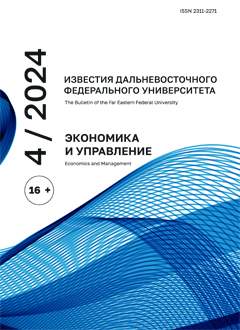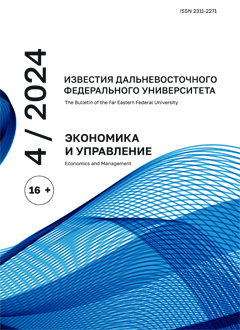Public Administration of Peripheral Territories: Assessing the Performance of Institutional Development Programs
DOI:
https://doi.org/10.24866/2311-2271/2024-4/1639Keywords:
development programs, evaluation methods, periphery, economic behavior, incentives, privatization, institutional changes, regional economyAbstract
In this article, an analysis of existing methodological approaches to the evaluation of state development programs is made, the advantages and disadvantages of the applied methods are identified. Based on previous empirical studies, a methodological approach to the evaluation of institutional development programmes in the periphery has been proposed, which includes collection and processing of both quantitative and qualitative data on actual implementation results. The proposed methodology includes evaluation of the program institutional design, local practices of implementation at local level and incentives of the economic agents involved. The estimation algorithm is applied to land privatization programs, as the most common tool used for institutional development of the periphery.
Downloads
References
1. Друкер П.Ф. Энциклопедия менеджмента / Пер. с англ. — М.: ИД “Вильяме”, 2004. — 432 с.
2. Котов А.В. Оценка эффективности инструментов региональной политики // Экономика региона. 2020. Т. 16. Вып. 2. С. 352–362.
3. Махотаева М.Ю., Николаев М.А. Оценка управления социально-экономическим развитием. — СПб.: СПбГПУ, 2007. — С. 453–455.
4. Минакир П.А. Дальневосточные институциональные новации: имитация нового этапа // Пространственная экономика. 2019. № 1. — URL: https://cyberleninka.ru/article/n/dalnevostochnye-institutsionalnye-novatsii-imitatsiya-novogo-etapa.
5. Михеева Н.Н., Ананьева Р.И. Инструменты региональной политики. Оценка эффективности использования // Регион. Экономика и социология. 2011. № 3. С. 39–57.
6. Селявина E.А. Оценка эффективности государственных финансовых институтов пространственного развития: опыт России // Пространственная экономика. 2015. № 1. — URL: https://cyberleninka.ru/article/n/otsenka-effektivnosti-gosudarstvennyh-finansovyh-institutov-prostranstvennogo-razvitiya-opyt-rossii.
7. Ридченко А.И. Оценка экономического эффекта реализации инновационных проектов в регионе // ОНВ. 2013. № 3 (119). — URL: https://cyberleninka.ru/article/n/otsenka-ekonomicheskogo-effekta-realizatsii-innovatsionnyh-proektov-v-regione.
8. Феоктистова К.И. Инструменты региональной экономической политики, направленные на изменение качества институтов: теоретический подход к управлению и практика реализации в ДФО // Теоретическая и прикладная экономика. 2024. № 4. С. 87–106. — URL: https://nbpublish.com/library_read_article.php?id=72776.
9. Agranoff R., Radin, B. The comparative case study approach in public administration // Research in Public Administration. 1991. No. 1. P. 203–231.
10. Bagarani M. Applying Multicriteria Analysis in On-Going Evaluation of EU Structural Programmes // Yildiz Social Science Review. 2015. Vol. 1. № 2. P. 1–17.
11. Bachtler J., Wren C. Evaluation of European Union Cohesion policy: Research questions and policy challenges // Regional Studies. 2006. Vol. 40. № 2. P. 143–153.
12. Díez M.A. Evaluating new regional policies reviewing the theory and practice // Evaluation. 2002. No. 8 (3). P. 285–305.
13. Klijn E.H., Koppenjan J. Institutional design: Changing institutional features of networks // Public Management Review March. 2006. No. 8 (1). P. 141–160.
14. Kline P., Moretti E. Local economic development, agglomeration economies and the big push: 100 years of evidence from the Tennessee valley authority // The Quarterly Journal of Economics. 2014. Vol. 129. № 1. P. 275–331.
15. Leonard C.S., Nazarov Z., Il'ina, I. Property rights in land and output growth in Russia // Econ Transit. 2019. No. 27. P. 139–162. — URL: https://doi.org/10.1111/ecot.12186.
16. Revillard A. (ed.). Policy Evaluation: Methods and Approaches // Éditions science et bien commun. 2023. С. 317. — DOI 10.5281/zenodo.8327162.
17. Teiu C.-M., Juravle D. A practical approach on making use of case study research in economics // MPRA Paper. — University Library of Munich, Germany, 2011.
18. Vanthillo T., Verhetsel A. Paradigm change in regional policy: towards smart specialisation? Lessons from Flanders // Belgeo. 2012. Vol. 1 (2). P. 119.
19. Voigt S. How (not) to measure institutions. Journal of Institutional Economics. 2013. No. 9 (1). P. 1–26.
20. Wooldridge J. Difference-in-differences estimation (in Russian) // Quantile. 2009. P. 25–47.
21. Yin K.R. Case Studies // International Encyclopedia of the Social & Behavioral Sciences (Second Edition). 2015. P. 194–201.


